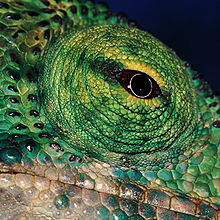The chameleon is among the most highly visually-oriented lizards, using this sense in prey capture, mating behavior, and predator avoidance.[1] Unique features of chameleon vision include a negative lens, a positive cornea, and monocular focusing. The development of the chameleon visual system could have evolved to aid in prey capture and/or in predator avoidance.

The angle, or amplitude, of eye movement in chameleons is very large for a vertebrate[1] and the eyes move independently of each other.[2] This allows a chameleon to watch an approaching object while simultaneously scanning the rest of its environment.[1] Chameleon eyes protrude laterally from the head, giving the lizard panoramic sight.[2] An eyelid fused to the pupil protects the eyes, leaving only a small part exposed.[2] With a negative (nearsighted or concave) lens and a positive (farsighted or convex) cornea, chameleons use a method of monocular focusing to judge distance called corneal accommodation. Each eye focuses independently, which is achieved by the chameleon eye’s unique anatomy of separated nodal and center points of the eye.[3] Finally, “striated rather than smooth ciliary muscle in sauropsids” allows for rapid focusing.[3]
- ^ a b c Lustig, Avichai; Hadas Keter-Katz; Gadi Katzir (2012). "Threat perception in the chameleon (Chamaeleo chameleon): evidence for lateralized eye use". Animal Cognition. 15 (4): 609–621. doi:10.1007/s10071-012-0489-7. PMID 22460630.
- ^ a b c Sandor, Peter S.; Maarten A. Frens; Volker Henn (2001). "Chameleon eye position obeys Listing's law". Vision Research. 41 (17): 2245–2251. doi:10.1016/s0042-6989(01)00111-0. PMID 11448716.
- ^ a b Ott, M.; F. Schaeffel; W. Kirmse (1998). "Binocular vision and accommodation in prey-catching chameleons". Journal of Comparative Physiology A. 182 (3): 319–330. doi:10.1007/s003590050182.